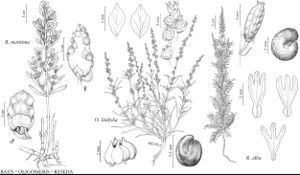Reseda
Sp. Pl. 1: 448. 1753.
Gen. Pl. ed. 5, 207. 1754.
| Taxon | Illustrator ⠉ | |
|---|---|---|
 | Batis maritima Oligomeris linifolia Reseda alba | Yevonn Wilson-Ramsey Barbara Alongi Barbara Alongi |
Herbs [subshrubs], annual, biennial, or perennial. Stems erect to ascending (ribs longitudinally marked), simple or branched (usually distally). Leaves: usually rosulate; alternate; usually petiolate (sometimes cauline subsessile); petiole (slender) much shorter than blade, sometimes winged; blade margins entire, pinnatisect, or lobed, lobes 1–11 (–15) on each side. Inflorescences racemes (sometimes lateral from distal axils). Pedicels present (sometimes only 1 mm). Flowers: (rarely almost actinomorphic) sepals persistent or deciduous, 4–6 [–8], basally connate (alternating with petals [sometimes accrescent]), usually unequal (adaxial larger); petals 4–6 [–8], distinct or basally connate, margins usually incised, sometimes entire; intrastaminal nectary-discs present; stamens [7–] 10–40; filaments persistent or deciduous, basally connate; ovaries [2–] 3–4 [–5] -carpelled (stigmatic teeth as many as carpels, placenta sometimes forked apically). Capsules erect or pendulous, angled, cylindric, ovoid-oblong, subglobose, or ovoid, walls membranous or chartaceous. Seeds (10–ca. 30) papillose, rugose, or smooth (sometimes with caruncles). x = 5, 6, [7, 8].
Distribution
Introduced; Europe, sw Asia, n Africa, n Atlantic Islands, also in n, c Mexico, South America, c Asia, s Africa, Australia
Discussion
Species ca. 65 (4 in the flora).
The four species of Reseda in the flora area represent four sections of the genus, which facilitates identification within this taxonomically complex group. Reseda alba and R. lutea are the most polymorphic species within their respective sections. The great morphological variability within these taxa helps to explain the specific and infraspecific taxa that have been described, most of which are of little taxonomic value. This polymorphism has been related to polyploidy.
Reseda is of limited economic importance. Some species, including three treated here, are cultivated as ornamental annuals. Reseda odorata has been cultivated as a fragrance plant since Roman times. Reseda luteola has been used as a dye plant and R. alba as a potherb in some regions of Europe.
Reseda phyteuma Linnaeus, a close relative of R. odorata, is known in the flora area only from nineteenth century collections around ballast from ports in New Jersey, New York, and Pennsylvania (e.g., A. Brown, 1878, NY). It has not been found in the flora area for more than 100 years and was never widely present.
Selected References
Lower Taxa
Key
| 1 | Capsules 4-carpelled, apically 4-toothed; leaf blades pinnatisect (lobes 4-15 pairs); stamens 10-14. | Reseda alba |
| 1 | Capsules 3-carpelled, apically 3-toothed; leaf blades entire, subentire, or ternately to biternately lobed (lobes 1-3 pairs); stamens 12-40 | > 2 |
| 2 | Sepals 4; leaf blade margins entire or subentire; placentas forked distally; filaments persistent. | Reseda luteola |
| 2 | Sepals (5-)6; leaf blade margins entire or ternately to biternately lobed; placentas entire; filaments deciduous | > 3 |
| 3 | Seeds glossy, smooth; capsules usually erect; sepals not reflexed in fruit; petals yellow, lateral lobes of adaxial petals entire or incised. | Reseda lutea |
| 3 | Seeds dull, undulate-rugose; capsules deflexed or pendent; sepals reflexed in fruit; petals white or light yellow, lateral lobes of adaxial petals deeply laciniate. | Reseda odorata |